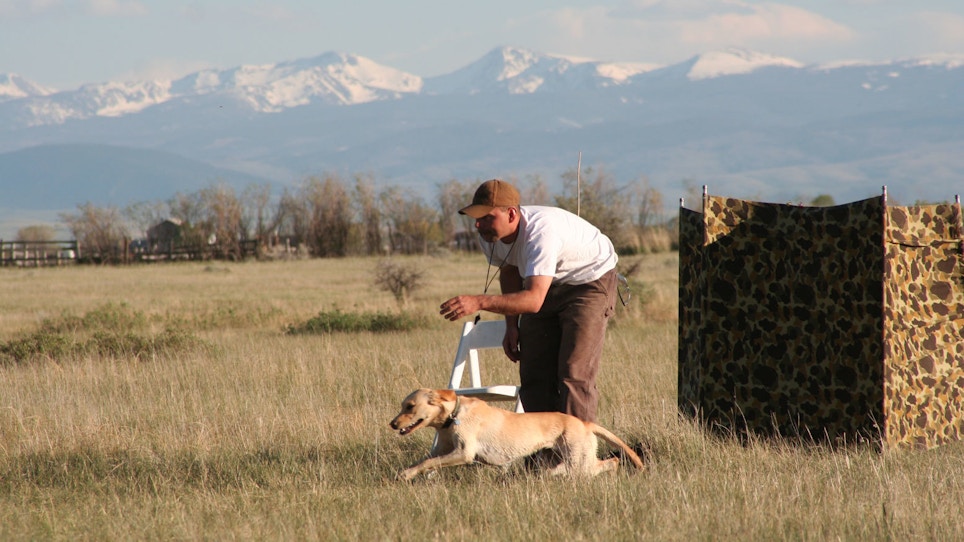John Luttrell has been training retrievers professionally for 20 years, so he’s earned the right to his opinions, among them the value of a steady retriever.
Nearly all professional trainers recommend steadying your dog, of course, but many hunters fail to take that advice.
Luttrell wishes they would.
“To tell you the truth,” he says, “I can’t think of one good reason not to do it. I don’t see any situation where it’s an advantage to have the dog break. Dogs don’t mark as well when they’re moving; generally they break too early, so they flare ducks; and for sure, if the dog breaks on the first bird that falls, he never has a chance to see the second or third bird that goes down."
Luttrell says the biggest reason of all is safety.
“I mean, without even thinking very hard, I can name five dogs that were shot waterfowl hunting because they broke. And that’s not a good way to start the day.”
Related: The Best Time To Feed Your Hunting Dog
Proper gundog training starts with puppies
Luttrell takes a holistic approach to training his labs. Before he can stop a dog from chasing a bird, that same dog, as a puppy, first has to learn to chase them.
“The way I do it is I get young dogs crazy about retrieving, and then I slow them down,” he says. “Some dogs we wait on and don’t start steadying until they’re 10 months old, and others we’re starting steadiness at 5 months old because they’re berserko for birds — if we didn’t start then we’d never get it done. It’s the way I teach everything: I teach the dogs what I want them to do, and then slowly bring in more and more kinds of disciplines to work on that particular problem or command.”
With retrievers, Luttrell says, steadiness training starts with the command “sit.”
“It’s just the sit command,” he says. “I don’t care what else is going on, if I’ve told the dog to sit, he has to sit. Once I’ve got a young dog retrieving hard, I start in with obedience, choke chains and so on, and as they get further into that I start collar conditioning, then put them through a force-fetching program. All of those things come together to create a dog that is obedient, retrieving to hand, and steady. But force-fetching is critical. To me, it’s very hard to steady a dog really good unless they’re force-fetched. And the reason for that is, at a certain point, unless you can make them go and get the bird, you’re gonna put too much pressure on them, and when you tell them to go, they’re gonna refuse. Then what do you do? You can happy them up, you can beg them, but if they haven’t been force-fetched, you can’t force them to go get the bird.”
Related: What do hunting dogs dream about?
How to train your own gundog
What are the concepts you can take home from this? There are two. The first is that the dog has to be crazy about retrieving before teaching him to momentarily abstain from retrieving — i.e., steadiness training — will work. In other words, the dog must have a strong, fully developed drive to go get the bird or steadiness training can actually hinder that drive. “The line for steadiness is razor thin,” Luttrell says. “If I’ve got the dog excited to retrieve, it gives me a little more margin for error.”
The second concept is that once a dog is ready to begin steadiness training, it’s important to tailor the dog’s training to his level of intensity. “I start by sitting with the dog and having my assistant throw birds,” he says. “And then, say, after eight or 10 birds, my assistant goes and picks up all the birds, and the dog doesn’t get to pick up any of them.” The dogs don’t like that, but Luttrell insists that they sit calmly before they get to make a retrieve.
“When they sit still, you send them and let them go get the bird,” Luttrell says. “And pretty soon a light bulb goes off: It’s like, ‘Hey! Now I understand how this game works!’ When you’re dealing with dogs with varying levels of intensity, some dogs you might only throw three birds before you let them go pick one up, and other dogs you can throw a hundred. With dogs that don’t have as much intensity, and you throw 10 birds for them, by the time you throw the eighth they don’t even care any more. But a high-intensity dog may take 20.”
Later, distractions are added, including throwing and shooting live birds, but the basic principle remains the same: the dog must remain sitting until told to retrieve.
Luttrell carries through with that line of training right into the first few days of the hunting season. “It’s the same deal, just like we talked about,” he says. “I’m going to sit there with a leash, the dog’s going to sit next to me, and I’m not shooting. I’m running the dog. Until they’re comfortable and confident to where I don’t have to hold the leash and I can see that they’re figuring out how this game works, that’s where I stay.”
Steadiness training takes a long-term commitment. But it’s a commitment, Luttrell believes, that will increase your dog’s effectiveness and protect his safety at the same time, and for those two reasons alone is worth every difficult minute spent.
Related: Two commands your hunting dog must know






